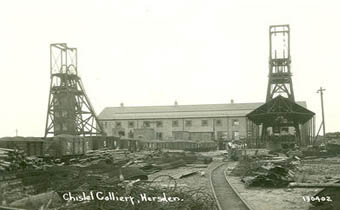
history |
On average over 200 unique visitors download this page, thats over 70,000 visitors per year and rising. Advertsie your business on this website and support your local ex-miners community |
|---|

Chislet CollieryIn 1911 The Anglo Westphalian Coal Syndicates Ltd decided to explore the possibility of workable coal seams in the Canterbury area ,after the sinking of bore holes in the area they put forward plans to sink two shafts on land at Chislet Park with the possibility of opening up The Sarre Pen to take the coal away by sea at Reculver.Having been refused permission to do this a decision was made to move the sinking to land near Westbere Court with the road on the north side and the railway on the south these could be used to move the coal. In May 1914 work started on the sinking of the first shaft. The borings had shown that the ground to be of broken chalk full of water so the Cementation process was used whereby cement was injected under high pressure into the chalk and fissures to consolidate the ground. When war broke out in August 1914 the German personnel were removed and on 24th November 1914 the name was changed to The Chislet Colliery Ltd and sinking resumed. Later the Government stopped the sinking after questions were asked about the German personnel who had worked there previously. Suggestions were made that somehow the tunnels at Chislet were to be used by the German military but after a visit by British authorities it was given the all clear and sinking resumed. In 1918 the first shaft the north reached the coal seam to be worked; the No 5 seam later to be reclassified as the No 7 seam. One year later the South shaft was completed by 1919 coal was being wound in saleable quantities by 1923, 223.733 tons. With the lack of repairs and a series of strikes during the 1920 by 1929 the company was in serious financial difficulties and one of the countries mining engineers Mr Forster Brown was brought in to reorganise the running of the company and the colliery. By 1936 saleable output had reached 486.192 tons but the war years saw a drop to 300.000 tons due to the loss of manpower with men leaving the industry to join the armed forces. (The government at this stage brought in a scheme to direct men who had come of age to go into national service to be directed into the mines “The Bevin Boy Scheme”) After Nationalisation in 1947 the colliery was extensively modernised and by 1951 output had again reached 400,000 tons and the years 47 – 59 were profitable ones, all the coal during this period was hand filled and the manpower peaked in 1957 at 1,681. In May 1968 the Kent area manager visited Chislet and said it was their intention to change the working methods at the colliery, the pit was to change from traditional methods to short wall retreat and it was during this period of change that the Coalboard put into action a notice of jeopardy for the colliery. From this point on it became clear that the board was going to close the colliery and try and use the men to boost the manpower at the other three collieries. On 26th July 1969 Chislet worked its last shift.
|
|
|---|

